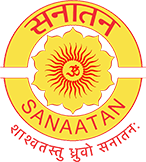-
Social Media
-
Post Content
- Donate
-
Log in
Welcome to Sanaatan Sansthan
Sanaatan Sansthan
To promote Sanaatan Narrative, Sanaatan Sansthan will build a world-class complex (about 100 acres in area) to showcase all tenets - Philosophy, History including Struggles, Mandir, Arts & Sciences, and Customs & Traditions - of Sanaatan Dharma that includes all Indic darshans like Jain, Buddh, Sikh, and so on. It will enable all people, at any level – elementary to research scholars, to learn about Sanaatan Philosophy and Society.
While we wait for resources needed to build the physical complex, this website will enable collection, collation and verification of content for the physical complex.
For introduction, please watch: What is Sanaatan Sansthan, Why Sanaatan Sansthan and Its Vision.
Schematic Layout

3-D Visualization


Recent Articles
Siksha
Siksha deals with phonetics, the pronunciation and accent.
Chhand
From: Hindupedia
Chandas is the science of metres. Syllables are classified into two categories, Guru and Laghu. A string of Guru-Laghu sequence of a particular length is called a metre. There are various metres in which the Vedic mantras are composed, such as Gayatri, Anusthup, Trishtup and Jagati. The chandas of a mantra determines its usage, such as its purpose and context. But it acts more as an error-correcting mechanism. Since the Veda is an oral tradition, any aberration in the chandas because of error in text or the swara, can be easily identified and corrected. Text: Pingala's Chandassastra.
Sanaatan Contents on Social Media
YouTube Channel :- https://www.youtube.com/@sanaatansansthan
Facebook Page :- https://www.facebook.com/sansansthan/
Upcoming Videos/ Live Stream:
Past Videos/ Live Streams
BAPS-Robbinsville,NJ-USA
Beautiful BAPS temple at Robbinsville, NJ. Visit BAPS Shri Swaminarayan Mandir, Robbinsville to learn more.
Overall-16Sanskar
| Garbhadhan (Conception) | is performed with an objective of the development and continuance of the progeny of the parents and with a view to get a noble and intelligent child. |
| Punsavana (Fetus Protection) | For the physical and mental development of the baby in the womb of the mother |
| Simantonayana (Satisfying Wishes Of The Pregnant Mother) | performed at different stages of pregnancy, objective to keep the mother free of any worry. The fetus emulates the achar-vichar-shravan. |
| Jatakarma (Birth Rituals) | It is performed on the six days from the birth, for the purification of the house. Honey and Ghee is also touched on the lips of the child. It is also called Shashthi [6th] pooja. |
| Nam)karan (Name–Giving | It is performed on 10th, 11th or 12th day. The child gets name from the Hora Shatra, based on 27 Nakshatra and the position of the moon at the time of child’s birth. |
| Nishkramana (Taking The Child Outdoors) | The child is taken out of the home for the first time and sees the Panchmahabhut. It is done at the time of Namkaran or on 4oth day or other day, as per local custom. |
| Annaprashana (Giving The Child Solid Food) | On sixth month, the child is given solid food (anna) for the first time, with poojan of Annapurna Devi. |
| Chudakarana Or Mundan (Hair Cutting), | Between the age of one-three- five years from the birth, hair of the child is removed. |
| Karnvedh (Ear Piercing) | Ears of a child pierced in the third or fifth year, with the commencement of Surya Puja; the father says “Oh God may we hear bliss with our ears” in the right ear of the child. |
| Upanayana Or Yagyopaveet (Sacred Thread) |
It is the ceremony of wearing the sacred thread called Yajnopaveetam [Janeu]. It is generally performed between the age of 5 and 12. This Sanskar is second birth for child – A spiritual birth. The ceremony has six parts: –
|
| Vedarambh (Study Of Vedas And Scriptures) | It is done along with Upanayana, starts in the learning of Vedas and Upanishads in ‘Gurukula’ or ‘Pathashala’. In the beginning of each academic period there is a ceremony called Upakarm and at the end of each academic period there is another ceremony called Upasarjana. |
| Samavartana (Completing Education) | It marks the end Brahmacharya Ashram and end of formal education. |
| Vivaha (The Marriage), Vaanprastha) |
It denotes the entry into the Grihast Ashram. Vedic marriage is viewed as sacramental, and is a lifelong commitment of one wife and one husband. (PAY BACK PITRI-MATRI RIN) |
| Vaanprastha |
This ceremony marks completion of Grahastha Dharma. (PAY BACK RISHI RIN) |
| Sanyasa |
A sanyasi is supposed to renounce the world and lead a life of study and meditation by living on alms. |
| Antyeshti (Last Rite). |
Antyeshti (Antim-Sanskar - Last Rites). When death is imminent, a small piece of gold, tulsi leaf and drops of Ganga water are put in the mouth of the person on the death bed. The body is laid on the ground with the head towards the north. The eldest son generally performs the last rites. The dead body is washed, perfumed and wrapped in a new white cloth and decked with flowers.For ten days following death, food is not prepared at home and relatives and friends take the responsibility of getting food for the family. |
Katas Raj Temple Complex
| URL | Comment |
| https://simple.wikipedia.org/wiki/Katas_Raj_Temples | Good Introduction to the temple covering most of the aspects of this temple. |
| https://www.sanskritimagazine.com/katas-raj-temples-pakistan/ - by Adeel Makhdumi | It has photos of all the temples and includes description of Mahabharat in brief. |
| https://www.worldhistory.org/Katas_Raj/ by Muhammad Bin Naveed | Some history and architecture description. |
| https://www.mahashivratri.org/shiva-temples/katas-raj-temple-in-pakistan.html | Social and Religious aspect |
| https://rising-pakistan.com/katas-raj-temples/ | History and Beautiful photos |
| https://m.facebook.com/media/set/?set=KatasRaj |
Geography:
Katas Raj is an area located approximately 40 kilometers off Chakwal, Punjab, Pakistan. Its location on Google Map can be seen here
History
Bhagwan Shiv, while carrying the body of dead Sati, shed two drops of tears on here to form the Katas lake and other at Pushkar, Rajasthan. Pandav, while in self-exile after Lakshagrih, stayed here and built earliest temples. Later rulers of Kashmir built modern standing structure during their reign from 625 CE to 939 CE.
Alexander Cunningham, the first Director General of the Archaeological Survey of India, in 1872-73 CE describes a Buddhist stupa 61m in height with ten streams around also existed there.
Architecture
These were built in Kashmiri architectural tradition and resemble the architecture of the temples of the Karkota and Varma dynasties who ruled from 625-939 CE. Certain defining characteristics such as dentiles, trefoil arches, fluted pillars and pointed roofs are present in most of the temples along the Salt Range foothills. The main building material is soft sand stone which is plastered over.
Philosophical
This area is called Dvaitavana in the Mahabharat and the series of questions between the Panda and the Yaksha took place here.
Social
Shivratri is celebrated here and many devotees from India also travel there. After 2008, Mumbai blast, Indian Hindus stopped travel but resumed in 2010.
Political
After partition, Pakistani government neglected the complex and it deteriorated. Pakistani Hindus and Hindus from India. The locals used the pond and the place for recreational purposes. The Indian Hindus were barred from visiting the temple in 1956, 1960 and 1965. The Indian Hindus were again permitted to visit the temple after 1984.
In the year 2005, L.K. Advani, the former Deputy PM of India, visited the site and was extremely dissatisfied with its condition. The scenario changed when the Pakistani government agreed to restore the temples to its former glory and also clean the pond. Hindu God's idols were placed in the seven temples after their restoration.
However, as of 2016, there is a suo moto case that has occurred due to the drying up of the pond as the water is being illegally used by the nearby cement factories. The Chief Justice Mian Saqib Nisar has also questioned about the absence of idols in the Shri Ram and Hanuman temples of the Satgraha.
Points to Ponder
Same as any other non-Muslim place of worship in Pakistan.
Sharda Temple in Multan, Pakistan
- Temple of Maa Sharda and
- The Sharda Peetham (Center for Advanced Studies)
And recently [on Mar 22 2023], Sri Amit Shah, home minister, India, inaugurated rebuilt Sharda Peeth temple at Teetwal near Kupwara, J&K on the Indian side of LoC.
| https://www.ikashmir.net/sharda/sharda5.html by Sanjay Godbole | Captures the story Maa Sharda as narrated by Shri Shambhunathji Thusu, 94 years old [in 2023], gives references of many other travelers and experts. |
| https://www.sunyaias.com/blogs/mata-sharda-devi-temple | Point-wise summary of this temple. |
| sharda temple in shirdi village multan pakistan - Google Search | Google Images of the Temple and the Peeth |
| https://www.youtube.com/watch?v=7lTVmpP9hc4 | A Video showing return of land for construction of Sharda Temple in Jammu regions [Indian Side of LoC]. |
| https://www.sanskritimagazine.com/sharda-temple-pak-occupied-kashmir/ | Quite detailed information about this temple. |
| https://en.wikipedia.org/wiki/Sharada_Peeth | Wikipedia link |
| WION's exclusive ground report from Sharada Peeth corridor inside PoK - YouTube | Wion reporting |
Geography
- The village is located on the South-West Bank of river “Krishna Ganga or Madhumati or Neelam”, between Gurez and Keran (Karna).
- The temple was situated on a hillock, on the right' bank of river.
- It is situated at a distance of 130 Kms from Srinagar and 140 kms. from Muzaffarabad. Its current postal address in PoK is: Village Shardi, Tehsil Atta Mukam, District Muzafferabad.
- There is a place called "Tikkar" at a distance of 1.5 Kms from Kupwara, in Kashmir. From here, there is a short cut for going to Shardi which measures 40 kms.
History
- Land of Rishi Kashyap, origin of temple?
- A Gaud King had restored the "Sharda Temple Complex" in ?
- After the Mughals, the Dogra regime assumed power in Kashmir. Their Collector of Muzaffarabad, Col. Gundu repaired the temple and provided a new ceiling made of wood. He got fixed an annuity for the priest of the temple, under the orders of Maharaja Gulab Singh of Kashmir.
- Prior to the partition of India, many Kashmiri Hindu families, saints, ascetics and their associates/ disciples and their servants, were settled in Shardi.
- Sikander Butshikhan destroyed the temple as well as the Peeth in ?.
Architecture
- Wreckaged remains of the temple of Goddess Sharda can be seen.
- It had the main girdle of 22 feet dia and the main entrance door in the west with foot steps.
- The rectangular sanctum had 63 foot steps, each 9' wide.
- The other entrances had 20 feet high arches. On both sides of the porch, there were two square shaped pillars, 16 feet high and 2'6" x 2'6" in sectional size, carved out of a solid stone block.
- The construction inside the temple was very plain and unadorned.
- The Architecture of temples in Kashmir is different than temples at other places. This style was developed, during the reign of King Lalitaditya (724 A.D.) and in 9th Century reached its Zenith, during the regime of Avantiverman.
- Generally, a temple in Kashmir has two parts, a square sanctum and a porch in front of it. These structures have centres and subcentres of Learning associated with them. There is an expansive courtyard around the temple.
- The pillars and columns of Kashmiri temples are of Derrik style.
Philosophical
The name and fame of this Sharda Teerath was well spread throughout ancient India. It was equally famous like Som Nath of Gujarat, the Vishnu Temple of Thaneshwar, and the Sun-Temple of Multan.
Social
- A fair used to be held at Shardi in the month of Bhadrapada [Bhado] on the eighth day of Shukla Paksha. 1000s of devotees from all over India, flocked the place.
- The Kashmiri Scribes, kept their Bhurjapatra manuscript covered in a platter overnight, in front of Goddess Sharda, for obtaining her blessings. If the pages of writings remained undisturbed, it was taken for granted that the works had the blessings of the Goddess. If, however, the pages of the works were found sifted, the works were considered as disapproved by the Goddess.
Political
The Save Sharda Committee (SSC), founded by Sri Ravinder Pandita Ji, is taking the lead in campaigning to start the pilgrimage to Sharda Peeth Complex. As of May 2023, GoI and GoP are in talks to start this corridor, local assembly of PoK has agreed to this proposal.
Points to Ponder
- It's obvious Muslims destroyed it, so there is nothing to ponder about. It is well known that Islam encourages destruction of places of worship of all communities except its own denomination.
- Sikander Butshikhan - the destoryer ruler died in 1413, and there after it was rebuilt/ repaired by Collector of Muzaffarabad, Col. Gundu [under Dogra Regime]. So, it was further destroyed after 1947 and Government of Pakistan/ PoK was neither interested nor capable of protecting it.
- Hindu population has beentotally eliminated, so even if world [mostly Sanaatani people, but also other well-meaning, civilized people] restores it, can Pakistan Government or PoK or UN or any other [to be created] administrative body take the responsibility of protecting it?
- Would it be worth while to restore it? It should be considered human heritage. It is our ancestors' [including ancestor of current people of Pakistan, who now follow Muslim way of life], achievements.
Sanaatan-Sanskriti-Book
Effective product descriptions can possibly lure potential customers. Good product descriptions can potentially influence a purchase decision. Great product descriptions can ultimately help improve conversion rates and increase sales, as well as boost your visibility and SEO on paid channels.
Ved-vs-Purans
Ved and all its associated scriptures [Vedangs, Brahmans, Aranyaks, Upnishads], plus Darshan-shatras describe rituals [Karm-Kandas], essential philosophy, prayers to various deities. However, their main purpose is philosophy [Gyan].
Puranas are generally speaking of TWO types -- Historical in nature and stories with the purpose of developing Bhakti in people. Harivans Puran is historical where as Devi Puran is for Bhakti. In Historical purans, God doesn't appear when a discipline does pooja [tap]; whereas in puranas that intend to promote faith in God, God appears very quickly, gives boon [vardaan] to the person doing tap, punya is rewarded quickly and paap is punished quickly too. The relationship between karm and Karmfal is shown explicitly and quickly, this drives masses to Bhakti -- pooja-path.
Both have their purpose in society. On one hand we find many Rishis spending their lifetime capturing Gyan in the form of Veds and related scriptures including Smritis, adding commentary to Upnishads etc. Rishies in this category are many -- Yajnavalkya, Manu, Vishwamitra, Vashisht, Adi Sankarcharya, Ramujacharya, Ballabhacharya, Vivekanand and so on. Bhagwan Vyas falls in this category as well as he wrote or compiled many Purans as well.
Most of these, so called Dharma Gurus of recent time, tell stories from Purans. This is not necessarily reflective of their lack of knowledge of the essence of Vedic scriptures, but also due to the need of present times. The audience needs stories to be motivated to get to the essence. These gurus are serving a big cause of Sanaatan by keeping majority of less sprititually aware masses engaged and live a life of Sanaatani, even if they don't study scriptures. One day, these masses can be upgraded to read vedic scriptures with deep philosophical meaning.
Similarly, other scriptues aslo have different orientations, though telling the same story/ historical events. For example:
- Bhagwatam, Maha Bharat, Bhagwat Puran and Harivans Puran -- All these cover same subject, same time [kaal] but have different perspective because of different objectives. A few links on this are:
- Valmiki Ramayan and Tulsi Das- Ramcharit Manas -- Similar variation. A few links:
Efffect of Story Telling in the long term: Though no rigorous scientific [in modern terms] have been done to answer this question, here are my opinion:
- Positive: Keeps the story alive and this faith on Sanaatan Philosophy on-going. Society resisted on-slaught of invasion by Abrahmic religions.
- Positive: Provides an opportunity to educated massed on deep Sanaatan Philosophy that is bring back the crux of Sanaatan Civilization. If not for this, almost impossible to undo the damages.
- Positive: Enables people to people interaction and some cohesiveness of thoughts.
- Negative: Masses flock to any place that is called GODly by anyone e.g. Majaars including Ajmer Sheriff etc., Sai Shirdi Baba, anyone putting a Stone with some sindoor etc [remember PK cinema], doing any ritual for removing bad omen or for getting some rewards. Overall, breaking the link between Karm and Karmfal.
- Negative: Many people consider these stories as an end in itself and don't comprehend the main philosophy. For them, getting to actual philosophy effectively becomes Un-learning the stories and then learning the philosophy. A quite difficult task.
- Negative: There are many stories which are seemingly contractory [due to contextual differences] which confuses people a lot and then people justify their actions using these stories as convenient. For example, a saying -- nothing moves without will of God, can make people so lazy justifiably. Another example of Gaj [the elephant] and the Magar [the crocodile], one interpretation: as long as the Gaj felt he was strong, God didn't come to his rescue, when he gave-up and surrendered, God came and saved his life. Such explanation justifies people's in-action. [Philosophically, the interpretation should be: The Gaj first tried his best and then asked for God's help, when it was beyond his capacity.]
Since story-telling has been going on by so many Sadhus for so long that most people today think that to be Essence of Sanaatan Dharma and serious teachings by even modern saints - Shri Dayanand Saraswati, Shri Pandurang Shashtri Athwale, Vivekanand, and philosophical aspect conveyed by many others.
Gotra
Gotra on Wikipedia can be read here. [As of Jul 2023, this article needs lot of rework.] As usual, timings are relative to writing of scriptures, not the genesis of scriptures. The timeline used is the one assigned by Europeans to our history. We all know Ved Vyas categorized and compiled Ved during Mahabharat Kaal around 3100 BC. It contains good description, some genesis and reference to scriptures.
The opinion expressed that Gotra implies lineage meaning decedents of a person doesn’t sound logical to me. Number of Gotra varies in various sources and most of the time following rules are mentioned about gotra:
- It is named after a Saint/ Rishi.
- Marriage amongst the same Gotra is discouraged, considered bad.
Note: We know that in some of Bharat, marriage amongst relatives, especially between off-springs of Father’s sister and mother’s brother/ sister are practiced, in the name of wealth preservation.
Inferences from the above two observations are:
- A Saint/ Rishi used to run a Gurukul / Ashram where many students would reside during the early youth for education. The Rishi-Ma [wife of the Rishi] used to look after all the students. The whole ashram was a family.
- Once these students returned to their family after education, they could marry with students / their relatives from the same Ashram. Over time, this could become a close-knit group.
- Each such group would rival other such groups and may be cause of clash between such groups.
- Hence, Rishis decided to prohibit such practices and barred marriage within the group.
- Some went further to bar marriage where the gotra was same in up to 7 generations.
- The main objective was to keep harmony across these groups.
- In simple words, Gotra implies alumni and their decedents.
Since youths from all Varns could attend Ashram of the same Rishi, hence we find same Gotra in all Varns, Also, we don’t see Rishis running Ashrams exclusively for a given Varn.
Some other links:
| Genetics Behind Gotra | The Y-chromosome description is interesting. |
| Gotra-Kula-Marriage-Legal | Gotra variations, Legal Aspect of Marriage referencing gotra |
| List of Gotra | This is just one, and no authentic source, except for first seven based on Sapt-Rishi |
Digital Platform Build Status

Digital Platform Build Status
While the main goal is to create a large physical complex, in order to collect, collate and validate content we have decided to build a Digital Platform. The digital platform will help spread the message regarding all aspects of Sanaatan Philosophy and society.
The current status of the project is:
Physical Complex: No progress
Digital Platform: Has been built and lauched. Current Architecture is stable and ready to be populated with content. Many volunteers are needed to upload, validate content. If you want to volunteer, please send mail to: me.

About US
Sanaatan Sansthan (सनातन संस्थान), a social, educational, religious and charitable institution, aims to enhance global awareness of Philosophy, History, Struggles for survival, Arts & Science, and Customs & Traditions of all its denominations like Jainism, Buddhism, Sikhism, Arya Samaj etc. by providing an authentic source.
Read More

















